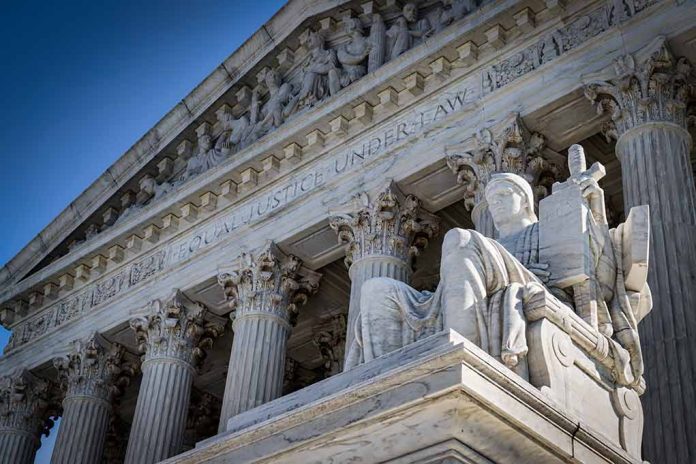
Chief Justice John Roberts has temporarily allowed President Trump to remove two board members from independent agencies, igniting a showdown over presidential authority that could reshape the balance of power in Washington.
Key Takeaways
- The Supreme Court has temporarily permitted President Trump to remove two Biden-appointed board members from independent agencies.
- The case challenges the 1935 Humphrey’s Executor decision that limits presidential power to fire independent board members without cause.
- The administration argues that forcing the President to work with agency heads opposed to his policies violates constitutional separation of powers.
- The affected agencies are the National Labor Relations Board and the Merit Systems Protection Board, which oversees federal worker disputes.
- Conservative legal theorists have long criticized restrictions on presidential authority to remove agency officials.
Supreme Court Intervention in Agency Leadership Dispute
Chief Justice John Roberts has issued an “administrative stay” allowing President Trump’s administration to temporarily remove two board members from independent agencies while the Supreme Court considers the broader constitutional questions at stake. The officials in question, Gwynne Wilcox of the National Labor Relations Board (NLRB) and Cathy Harris of the Merit Systems Protection Board (MSPB), were originally appointed by the Biden administration. The stay temporarily blocks a federal appeals court ruling that had ordered their reinstatement while legal challenges proceed.
The Supreme Court has requested briefs from the involved officials and set an expedited timeline, signaling the importance of this constitutional dispute. The Trump administration has asked the high court to review the cases quickly, potentially scheduling arguments for a special session in May with a decision expected by July. This timeline reflects the administration’s urgency in resolving what it considers a fundamental question about presidential authority.
Constitutional Questions at Stake
The case strikes at the heart of a longstanding constitutional debate about the limits of presidential power. At issue is the 1935 Supreme Court decision in Humphrey’s Executor, which established limitations on a president’s ability to remove officials from independent agencies without cause. The Trump administration is effectively asking the Supreme Court to reconsider or narrow the scope of this landmark ruling, which has shaped the relationship between the presidency and independent agencies for nearly a century.
“This case raises a constitutional question of profound importance: whether the President can supervise and control agency heads who exercise vast executive power on the President’s behalf, or whether Congress may insulate those agency heads from presidential control by preventing the President from removing them at will,” argued Solicitor General D. John Sauer.
Solicitor General D. John Sauer has emphasized that forcing President Trump to delegate executive power to agency heads who oppose the administration’s policies creates a situation that “causes grave and irreparable harm to the President and to our Constitution’s system of separated powers.” Conservative legal scholars have long criticized Humphrey’s Executor as an improper restriction on presidential authority that undermines the unitary executive theory of governance.
Trump vs. the Constitution: The Legal and Institutional Challenges of an Unconstrained Presidency
The second Trump administration presents a fundamental test for the resilience of the American constitutional system. With his return to power, the legal and institutional…
— Niels Groeneveld (@nigroeneveld) March 10, 2025
Practical Impacts on Agency Operations
The dispute extends beyond constitutional theory to have practical implications for government operations. The NLRB, where Wilcox served as the first Black woman on the board, has been left without a quorum after her removal, limiting its ability to resolve labor cases. Meanwhile, the Merit Systems Protection Board, where Harris served, plays a critical role in reviewing federal worker disputes and could impact the administration’s workforce reduction efforts.
“We acknowledge the concerns surrounding litigating and deciding the important questions raised by these cases on such a short timeline,” Sauer noted in court filings. “The President should not be forced to delegate his executive power to agency heads who are demonstrably at odds with the Administration’s policy objectives for a single day—much less for the months that it would likely take for the courts to resolve this litigation.”
The D.C. Circuit Court of Appeals had previously reversed a decision allowing President Trump to fire Harris and Wilcox, citing past Supreme Court rulings that upheld removal restrictions for officials on adjudicatory boards. Attorneys for Wilcox have argued that her firing lacked due process and was not justified by neglect or malfeasance, claiming that overturning established precedent is the administration’s “only path to victory.” The outcome of this case could significantly reshape how independent agencies function and their relationship with the executive branch.
Sources:
- Supreme Court allows Trump’s firings of independent agency board members to take effect, for now | AP News
- Supreme Court Sides With Trump, for Now, on Firing Agencies’ Leaders – The New York Times
- Supreme Court Lets Trump Move Forward With Firing Agency Leaders For Now | The Daily Caller






